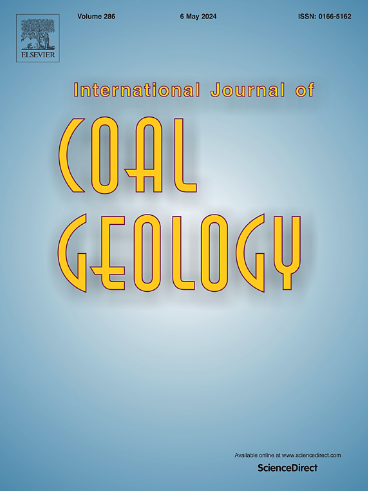气候驱动的宾夕法尼亚-二叠纪界线附近热带盘古大陆成煤停止以捷克Líně组冲积-湖相演替为例
IF 5.6
2区 工程技术
Q2 ENERGY & FUELS
引用次数: 0
摘要
在宾夕法尼亚-二叠纪过渡时期,热带盘古大陆气候季节性的增加对景观生境和陆生生物群的演化产生了重大影响。其中一个重要的结果是热带盘古大陆泥炭形成的停止——这是一个未被充分探索的问题,因为欧洲主要煤田的这个时代的演替要么没有保存下来,要么地层学上的限制很差。波希米亚盆地约1公里厚的Líně组(上gzhelian -下Asselian)以河流和冲积红层为主,与灰色湖泊沉积互层,记录了长达3.5 Myr的构造-沉积、气候和生物历史,这些历史已经通过TIMS年龄校准到宾夕法尼亚-二叠纪过渡。本文综合了露头尺度和盆地尺度的沉积相和陆生生物群数据,评价了气候和造山后构造过程对沉积和生物记录的影响及其对泥炭增生的影响。目前的资料表明,气候在约450 kyr尺度上在季节性较少和季节性较多之间振荡。在宾夕法尼亚晚期,季节性最小(最大)。湿度)支持了“湿河流系统”的存在,以及与流变性泥炭沼泽相衬的分生湖泊形成,而在最干燥的气候(最大湿度)下。季节性),排水良好的河流景观占主导地位的盆地低地。在早二叠纪,由于热带盘古大陆长期的干旱化趋势,排水良好的河流/小浅湖栖息地(“干河流系统”)盛行,湿地-旱地生物群落在盆地低地和/或邻近高地栖息地的保存窗口中大部分时间共存。然而,它们的比例随气候波动而显著变化。Líně Fm。沉积于后瓦里斯坎期板内伸展形成的半地堑盆地体系中。盆地充填反映了3个“裂谷期”:(1)起裂期,初始子盆地局部沉降和张开;(2)顶极,分布较广,沉降最大,子盆地相互连通,形成广泛的盆地体系;(3)逐渐减弱,可能以热沉降为主。本文章由计算机程序翻译,如有差异,请以英文原文为准。
Climatically-driven cessation of coal formation in tropical Pangea around the Pennsylvanian-Permian boundary; an example from alluvial-lacustrine succession of the Líně Formation (Czechia)
Increasing climatic seasonality within tropical Pangea during the Pennsylvanian–Permian transition had a significant impact on landscape habitat and terrestrial biota evolution. One of the important consequences was cessation of peat formation in tropical Pangea – an underexplored issue because successions of this age in major European coalfields are either not preserved or are stratigraphically poorly constrained. The about 1 km thick Líně Formation (upper Gzhelian–lower Asselian) of Bohemian basins dominated by fluvial and alluvial red-beds interbedded by grayish lacustrine deposits records ∼3.5 Myr long tectono-sedimentary, climatic and biotic history already calibrated by TIMS ages to the Pennsylvanian–Permian transition. By integrating outcrop- and basins-scale data on sedimentary facies as well as on terrestrial biota, this paper evaluates the effects of climate and of post-orogenic tectonic processes on resulting depositional and biotic records and their effect on peat accretion. The current data indicate that the climate oscillated in about 450 kyr scale between less and more seasonal. During the Late Pennsylvanian, minimum seasonality (max. humidity) supported presence of ‘wet fluvial systems’ and meromictic lake formation lined with rheotrophic peat swamps, whereas during the driest climate (max. seasonality), well-drained fluvial landscape dominated the basin lowland. During the Early Permian, well-drained fluvial/small shallow lake habitats (‘dry fluvial systems’) prevailed due to long-term aridification trend in tropical Pangea, and wetland – dryland biomes coexisted over most of the time in a preservation window of the basin lowland and/or adjacent upland habitats. Their proportion, however, varied significantly in accord with climatic oscillations. The Líně Fm. was deposited in a half-graben basin system formed in response to post-Variscan intra-plate extension. The basin filling reflected three ‘rift phases’: (1) initiation, with localized subsidence and opening of initial sub-basins; (2) climax, with more distributed, maximum subsidence and interconnecting of sub-basins to form extensive basin system; (3) waning, likely dominated by thermal subsidence.
Formation of major, basinwide Klobuky Lake was facilitated by wet period ocurring during the rift climax stage with the most rapid creation of the accommodation space. Peat swamps formed and the peat accreted only during the late Gzhelian up to TIMS calibrated C![]() P boundary. Increasing aridification, however, constrained peat swamps from floodplain to shallowed lakes, the water table of which suffered less from seasonal oscillations comparing to floodplain areas. Purely rheotrophic, usually high-ash peat swamps formed. The peat-swamp development was often interrupted by temporary rise of lake level and influx of clastic material. Resulting coal beds are usually few tens of centimeters thick, and if thicker, they commonly contain clastic partings or high-ash coal intervals. Peat-swamp vegetation is dominated by free-sporing plants, mainly ferns and sphenophytes, however, present are also lepidodendrid lycopsids. Since the beginning of the Permian, the aridification trend already did not support long-term and widespread peat accretion and the absence of economic coal beds is in agreement with replacement of meromictic lakes by shallow well‑oxygenated small lakes, increased proportion of red-beds and apparent reduction of wetland flora. Instead, drier habitats supported dryland biome dominated by walchian conifers and probably also by pteridosperms of peltaspermalean affinity.
P boundary. Increasing aridification, however, constrained peat swamps from floodplain to shallowed lakes, the water table of which suffered less from seasonal oscillations comparing to floodplain areas. Purely rheotrophic, usually high-ash peat swamps formed. The peat-swamp development was often interrupted by temporary rise of lake level and influx of clastic material. Resulting coal beds are usually few tens of centimeters thick, and if thicker, they commonly contain clastic partings or high-ash coal intervals. Peat-swamp vegetation is dominated by free-sporing plants, mainly ferns and sphenophytes, however, present are also lepidodendrid lycopsids. Since the beginning of the Permian, the aridification trend already did not support long-term and widespread peat accretion and the absence of economic coal beds is in agreement with replacement of meromictic lakes by shallow well‑oxygenated small lakes, increased proportion of red-beds and apparent reduction of wetland flora. Instead, drier habitats supported dryland biome dominated by walchian conifers and probably also by pteridosperms of peltaspermalean affinity.
求助全文
通过发布文献求助,成功后即可免费获取论文全文。
去求助
来源期刊

International Journal of Coal Geology
工程技术-地球科学综合
CiteScore
11.00
自引率
14.30%
发文量
145
审稿时长
38 days
期刊介绍:
The International Journal of Coal Geology deals with fundamental and applied aspects of the geology and petrology of coal, oil/gas source rocks and shale gas resources. The journal aims to advance the exploration, exploitation and utilization of these resources, and to stimulate environmental awareness as well as advancement of engineering for effective resource management.
 求助内容:
求助内容: 应助结果提醒方式:
应助结果提醒方式:


